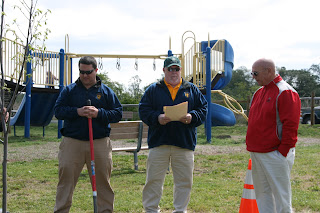 |
| DNR Arborist Terri Batchelor presents the Tree City Plaque |
National Arbor Day is celebrated on the last Friday in April. This year, we had a lot to celebrate. We were named a "Tree City USA" and we dedicated a "Liberty Tree".
The Town of Centreville has pursued the Tree City USA designation over the past several years. Some of the requirements include:
- We had to establish a Volunteer Tree Board, who is responsible for the care and management of the community's trees. The Town Parks Advisory Board members function in this capacity.
- We enacted a Tree Care Ordinance that designated the establishment of a tree board responsible for writing and implementing an annual community forestry work plan.
- We established a tree program with an annual budget of at least $2 per capita with evidence that the community has established a community forestry program that is supported by that annual budget. (This amount can be utilized as in-kind expenditures, including labor costs from Public Works, etc)
- We must hold an annual Arbor Day observance and proclamation with a simple tree planting event or an award ceremony that honors leading tree planters.
 |
| The planting of the Liberty Elm tree |
We also planted a "Liberty Elm" tree, which will provide shade for generations to come.
 |
| Council Vice President Sigler reading his Liberty Elm speech |
Council Vice President Smokey Sigler spearheaded this program, and here is the text of his speech explaining and commemorating the tree:
"The first, famous Liberty Tree stood on the Boston Common, an American Elm with a political history. The elm was a commons tree in the pre-Norman ‘English borough’ tradition: A place for the people of the shire to gather on their own terms and for their own purposes.It is our hope that this tree will continue to grow roots, provide shade, and promote liberty to all who encounter it. So, next time you're down at the Wharf, look for it and sit on the bench next to it, and ponder the meaning of the tree.
In the decade of agitation that fed into the American Revolution, Boston radicals rallied beneath the tree’s canopy, speaking against imperial authorities and calling for home rule in the colonies.
After the speeches, the people marched. In one case, hundreds of marchers ended their protest at the docks, where they cheered on scores of activists as they dumped East Indies Trading Company tea into the harbor. In another case, the march ended in a volley fired from imperial rifles, martyring Crispus Attucks and four others as the first casualties of the dawning revolution.
In the first months of the Revolutionary War, imperial troops occupied Boston, and cut the elm to the ground. Yet the Liberty Tree lived on. In hundreds of towns, and in every colony, the revolutionaries consecrated new Liberty Trees and Liberty Poles, and flew their likenesses on their flags.
Thomas Paine wrote of the Liberty Tree in poetry and prose, and soon the tree was an international symbol. The French revolutionaries hailed the tree, as did the Irish republicans. In Haiti, the great Toussaint L’Ouverture prophesied:
By overthrowing me, you have succeeded in cutting down the tree of liberty of the blacks in Santo Domingo, but have failed to destroy the roots that are deep and strong. The tree will grow again."
 |
| Tree City USA Flag! |